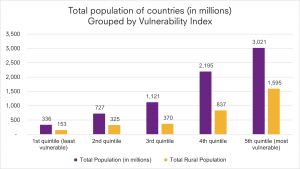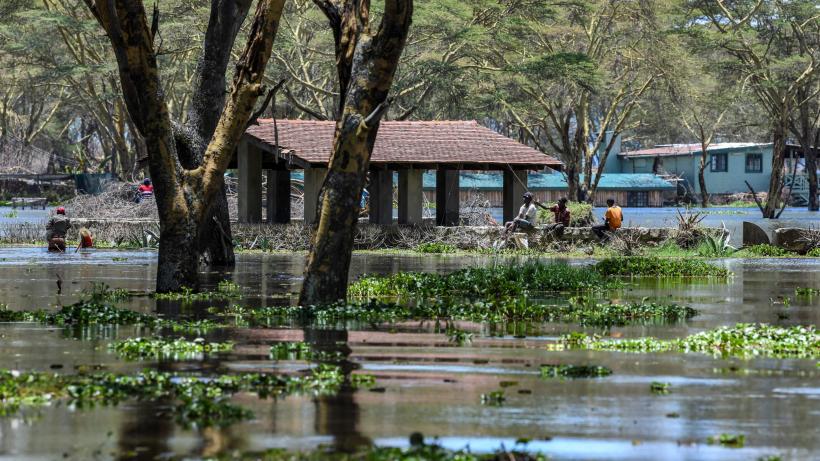As climate-related natural disasters occur with increasing frequency, disproportionally impacting poorer countries, robust social protection systems will become ever more necessary. Despite a wealth of evidence on the economic benefits of social protection, spending and coverage in low-income countries are inadequate to combat the effects of climate change. However, recent experience from the growth of social protection systems in some poorer countries offers encouraging and important lessons.
Intense climate-related disasters, such as floods, droughts, and heatwaves, have been steadily increasing worldwide. A recent assessment of the global damages from natural disasters shows that total annual damage has increased ten-fold between 1976-85 and 2005-2014, from US$14 billion a year to US$140 billion a year. These disasters have disproportionally affected the poor, both within and across countries.
Where do climate-vulnerable populations live?
Beyond their immediate and visible impacts, the effects on people’s assets, livelihoods, health, and ability to save can have devastating consequences that last for years, returning people to or keeping them in poverty. Farmland and urban coastal areas are particularly vulnerable. Between 1970 and 2010, the world population grew by 87% on average, while populations in flood plains grew by 114% and in cyclone-prone coastlines by 192%. A ranking of all countries by climate vulnerability reveals that the bottom two quintiles (i.e. the 40% that are most ‘at-risk’) cover 70% of the world’s population. The majority of this population comes from low- and middle-income countries, particularly in Africa, and South and East Asia.
Figure 1: The Most Vulnerable Countries are the Most Populous

Disasters can increase poverty through two channels. First, reductions in aggregate economic growth, which is the main driver of poverty reduction over time, have been observed consistently across countries that experience severe and frequent natural disasters. Second, even in the absence of visible impacts on GDP, poverty can increase through direct reductions in the wealth and incomes of the poor, leading to increases in inequality. The poor generally invest less in preparedness and risk reduction, hold lower quality assets, depend more on vulnerable agricultural income and ecosystems, and are more food-insecure. A combination of social protection programmes that both i) encourage long-term resilience and shifts to more productive livelihoods, and ii) are responsive to sudden shocks and provide immediate relief, will play an important role in adapting to climate change.
Climate-vulnerable countries are not spending enough
Social protection instruments come in various forms: long-term cash and in-kind transfers that can improve human capital and reduce exposure to risk, post-disaster or ‘adaptive’ transfers that provide timely support to the most needy, agricultural insurance that can encourage technology adoption and switching to more resilient crops, and workfare programmes that encourage revenue diversification. However, the coverage of and investments into these programmes in climate- vulnerable countries is unfortunately very inadequate. South Asia and Sub-Saharan Africa spend US$28 and US$34 per capita respectively, on social protection, compared to US$4,369 in Europe/Central Asia and US$11,467 in North America.
On average, the world’s most vulnerable countries (defined as the bottom quintile excluding the US and Europe) spends US$100 per capita, compared to US$723 for the rest of the world.[1] This is driven partly by the fact that these countries are much poorer and lack the fiscal space required to deliver adequate programmes. The per capita GDP for this bottom quintile of countries is US$2,870, compared to US$8,555 for the rest of the world. However, GDP per capita is not the only factor. India and Portugal are the 17th and 18th most vulnerable countries in the world, but while India’s GDP per capita is 10 times less than Portugal’s, its social protection spending is 137 times less.
[1] Based on authors own analysis using data from GermanWatch Climate Vulnerability Index, World Bank ASPIRE database of social protection indicators, and ILO database on social protection spending and country populations.
Fig 2: Social Protection Spending by Region

Yet, the benefits of social protection are clear
Despite this worrying lack of financing, there is ample evidence to show that social protection programmes can build resilience to climate-related natural disasters. In Bangladesh, the Chars Livelihood Programme protected 95 percent of recipients from losing their assets after the 2012 floods. In Mexico, beneficiaries of Prospera, the national cash transfer programme, are less likely to withdraw their children from school after a shock. In Ethiopia, participation in the Productive Safety Net Program (PSNP) ensured that losses in consumption from drought were 25% less than non-participants. A systematic review of the evidence of the impact of social protection programmes in Sub-Saharan Africa shows that cash transfer programmes improve risk management through a variety of channels, such as increasing savings, accumulating productive assets, encouraging crop and livelihoods diversification, and improving community ties and reciprocity arrangements.
An analysis conducted by the World Bank also shows that social protection programmes are highly cost effective. The average benefit-cost ratio, including targeting errors, is 2.2 world-wide, and higher than 3 or 4 in many countries, especially poorer and more vulnerable ones.
So why do poor and vulnerable countries not spend more on social protection, especially towards climate change adaptation? Low per capita GDP and lack of fiscal space cannot explain the magnitude of the difference between rich and poor countries. Other explanations may include:
- A lack of capacity, technology, and data
- Leakage of benefits, mistargeting, lack of transparency, or imperfect markets leading to lower trust in government and consequently less citizen demand for social protection
- Huge informal workforces leading to challenges with targeting and consequently much higher administrative costs
Building climate-responsive social protection programmes
Although designing and financing effective social protection can be a challenge, recent experience from social protection systems globally offers encouraging and important lessons, especially in light of the on-going COVID-19 pandemic. It suggests that countries at all income levels can set up systems that increase resilience to natural hazards. But to do so, they have to ensure that the systems are rapidly scalable in case of crisis and feature targeting mechanisms flexible enough to adjust quickly to new situations.
Three key approaches stand out:
- Increasing the amount transferred by an existing programme to its beneficiaries or relaxing rules and conditionality so that the transfers increase
- Extending the coverage of an existing programme to include new beneficiaries
- Introducing extraordinary payments or creating an entirely new programme.
Insights from Vietnam and the Philippines
Two countries that offer valuable lessons are Vietnam and The Philippines. Both countries are comparably poor (in terms of per capita GDP) but more climate-vulnerable (in terms of their Climate Risk Index score) than some of their South Asian neighbours such as India, Pakistan, and Bangladesh. They also face similar challenges with financing these types of programmes – both have similar tax-to-GDP ratios, albeit slightly higher. Yet both countries on average spend more than four times per capita on social protection compared to South Asia, and have set up successful disaster responsive programmes.
Fig 3: Comparing Philippines and Vietnam to India, Pakistan, and Bangladesh

In Vietnam, synergies between climate change adaptation and disaster risk reduction have been increasingly recognised as the shocks and stresses people face are becoming more and more intertwined. There is already a high degree of integration in Vietnam’s social protection and climate change strategies and policies. Vietnam’s National Strategy for Disaster Mitigation and Management in 2020 articulates that “measures for disaster mitigation and management must be compatible with measures for poverty reduction and natural resource protection, so that development can be equitable and sustained”. By introducing a national Community Based Disaster Risk Management Programme in 2009, the Government established a coordination mechanism to integrate climate-related risk across the strategies and targets of various ministries and civil society organisations responsible for delivering social protection. A number of programmes in Vietnam now incorporate dedicated flexible funds that can be repurposed in response to disasters.
The Philippines experienced a catastrophic disaster, Typhoon Yolanda, in 2013. One of the most powerful tropical cyclones ever recorded, Yolanda killed 6,600 people, displaced hundreds of thousands of others, and caused US$13 billion in damages. The Philippines already had a strong social protection system in place that was able to mobilise various components and converge different programmes to channel relief to those most affected. The Pantawid Conditional Cash Transfer Programme was quickly modified by dropping conditionalities and expanding coverage using The National Household Targeting System for Poverty Reduction, an existing database of the poor and vulnerable. Other programmes such as cash-for-work and cash-for-asset rebuilding were combined with the Pandawid scheme and were offered to a wide swathe of affected households. Policymakers are now focussed on further developing systems that can be scaled up quickly in response to disasters, building up technical infrastructure such as national identification systems, improving linkages between existing targeting systems and disaster response, and efficient data management and IT systems.
A global revolution in social protection
For other countries hoping to draw on these lessons, change must start with political leadership who must acknowledge the risks involved and generate the political will to improve social protection systems. The challenges are myriad: a rapidly increasing urban and informal workforce that are left out of traditional programmes, weak implementation capacity, and a lack of fiscal space, to name a few.
Encouragingly, however, we are seeing a global revolution in social protection programming in response to the COVID-19 pandemic. Between March 2020 and May 2021, a total of 3,333 new social protection measures were planned or implemented across 222 countries. This represents an increase of 148% since before the pandemic struck. In fact, 70% of all cash transfers schemes are new and in response to COVID-19. Governments must recognise that COVID-19 is not a one-off disaster, and we should expect the frequency of such natural hazards to only increase over time, whether it be through climate-related factors or other pandemics. What we have learnt through this pandemic, and the systems that have been designed in response, must serve as a basis for long term planning and resource allocation towards social protection.
This blog is part of IGC’s sustainable growth series.


